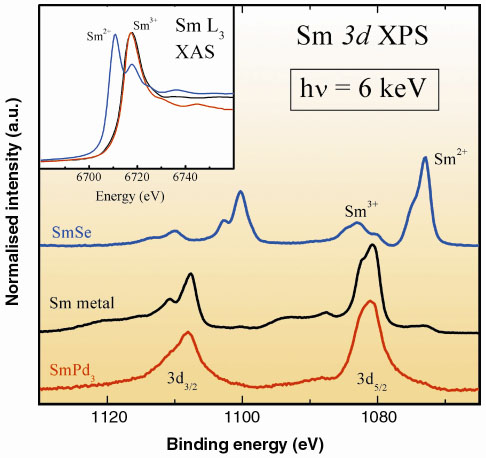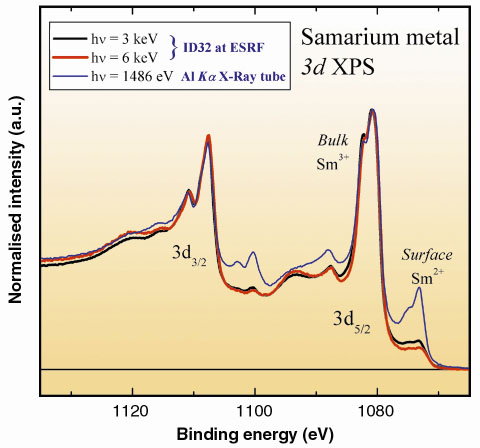- Home
- Users & Science
- Scientific Documentation
- ESRF Highlights
- ESRF Highlights 2001
- Magnetism and Electronic Properties of Solid
- High-energy Photoemission Study of the Bulk and Surface of Samarium Compounds
High-energy Photoemission Study of the Bulk and Surface of Samarium Compounds
Photoemission spectroscopy is a powerful tool for investigating the electronic structure of solids. It provides information on a topmost layer whose depth depends on the kinetic energy of the measured electrons. The minimum value of the electron escape depth (few Å) occurs for kinetic energies around 10 100 eV, while for increasing kinetic energies it gets larger. Hence bulk-sensitive information can be obtained in photoemission experiments only if high-energy electrons are detected. Few experiments [1,2] have been performed so far in the high kinetic-energy range, due to the unavailability of intense photon fluxes (required by the low cross-section values at high energy) and of analysers able to measure large photoelectron energies.
The analyzer limits were extended to their present capabilities in a recent experiment on ID32: we performed a photoemission study of samarium in selected samples that have different valence in the bulk and at the surface: Sm as a pure metal is divalent at the surface and trivalent in the bulk, in SmSe it is mixed valent, and in SmPd3 it is trivalent. Spectra of 3d core levels measured with high-energy excitation are largely bulk sensitive and allow the valence of the rare-earth component in the volume to be determined. Photon energies from 3 to 6 keV were used in order to investigate the change of the surface vs. bulk sensitivity.
 |
Fig. 109: Photoemission spectra of samarium 3d levels in three samples with different weight of the divalent and trivalent component in bulk and surface, after background subtraction. The L3 edge absorption spectra (inset) show less structure due to the larger lifetime broadening. |
Figure 109 shows photoemission spectra of the 3d levels of Sm in the different samples, excited at h = 6 keV. The peaks related to the Sm2+ and Sm3+ configuration are well separated and reflect the different valence states. It is interesting to compare the photoemission spectra with absorption spectra of the Sm L3 edge in the same compounds (inset of Figure 109): the two techniques have similar bulk-sensitivity (sampled depth ~ 40 Å) but the larger lifetime broadening of the 2p levels hides the small divalent surface component of metallic samarium in the absorption spectrum. SmSe, at variance with the previous samples, shows a clear Sm2+ feature.
The change of the surface vs. bulk contribution to the spectral shape is shown in Figure 110. Our photoemission spectra of the Sm 3d core levels are compared with a spectrum excited with a conventional X-ray tube. The spectral weight at lower binding energies originates from the divalent configuration present in the outer layers of samarium. A striking decrease of the surface component intensity is seen in the bulk sensitive spectra excited at 3 and 6 keV. The decrease of the divalent intensity when increasing the photon energy from 3 to 6 keV is slower than expected from the anticipated square root dependence of the escape depth on the photoelectron kinetic energy. This might perhaps indicate the presence of a divalent component in the bulk, or a trend of the escape depth different from what was derived from earlier data. Both hypotheses are challenging and deserve being studied on further samples and in a wider photon-energy range.
 |
Fig. 110: Photoemission spectra of 3d levels in pure metallic samarium. Spectra at 3 and 6 keV were measured at ID32 while the spectrum excited at 1486 eV was taken with an X-ray tube. A relevant decrease of the divalent surface component with increasing energy is seen. |
Authors
C. Dallera (a), L. Duò (a), G. Panaccione (b), G. Paolicelli (c), L. Braicovich (a) and A. Palenzona (d).
(a) INFM-Politecnico di Milano (Italy)
(b) INFM-Elettra, Trieste (Italy)
(c) INFM- Unita'di Roma III (Italy)
(d) INFM-Università di Genova (Italy)



